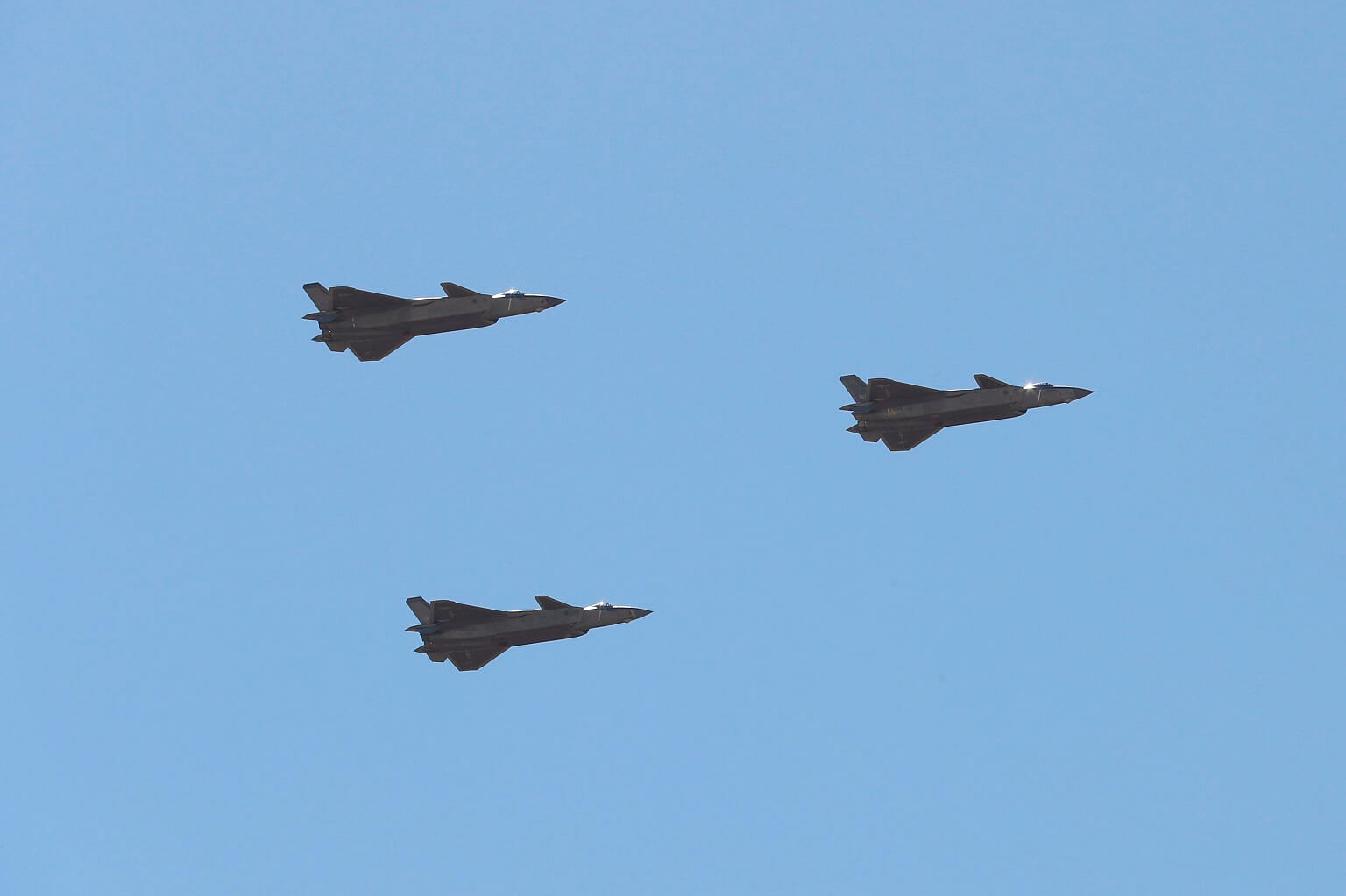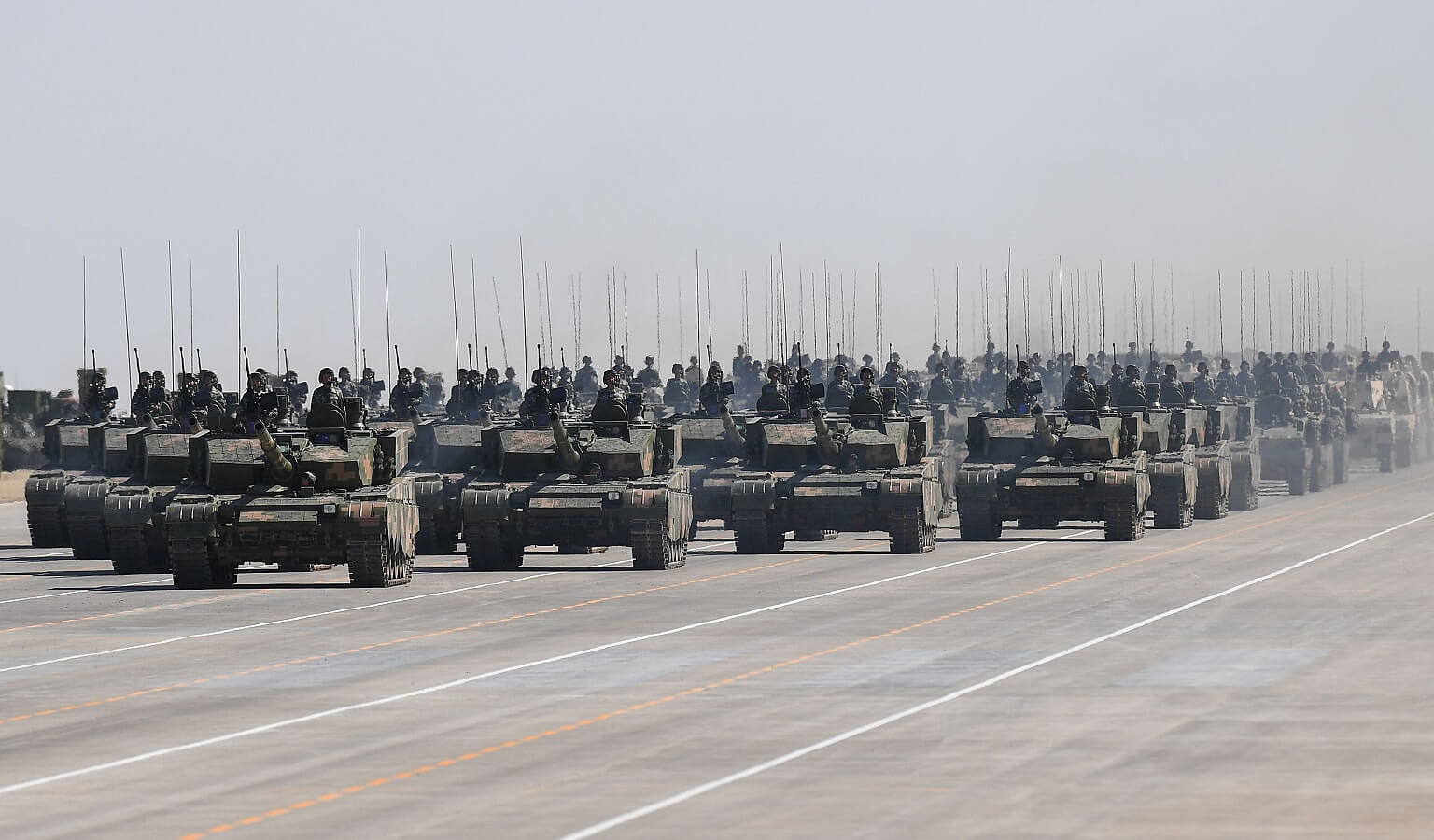BEIJING - China marked the 90th anniversary of the founding of the People's Liberation Army with a massive military parade on Sunday (July 30) at Inner Mongolia's Zhurihe military training base. Twelve thousand troops, more than 100 aircraft and 500 pieces of military equipment were on show.
It was the first time since 1949 China has marked the Army Day, which falls on Aug 1, with a military parade, said its official Xinhua news agency. Military parades are typically held at Beijing's Tiananmen Square to mark the founding of the People's Republic of China on Oct 1.
Sunday's parade was also notable in that almost half of the 600 pieces of hardware on show had never been paraded in public. Among these were the J-16 fighter jet, J-20 stealth fighter and the new-generation Dongfeng-31AG intercontinental missile, whose 11,000km range means it can hit parts of the United States.
Here are some vital facts about the People's Liberation Army, the Zhurihe army base and a close-up look at some of its newest, domestically-built military hardware.
The world's largest armed forces
With more than two million soldiers, the People's Liberation Army (PLA) is the largest standing army in the world, followed by the US, India and North Korea.
President Xi Jinping was designated commander-in-chief of the People's Liberation Army in April 2016 amid on-going reforms at the PLA.
Presiding over Sunday's parade in his capacity as the head of China's Central Military Commission, he called for unwavering loyalty from the army.
"Troops across the entire military, you must be unwavering in upholding the bedrock principle of absolute party leadership of the military," Xi said in a message that was broadcast across the country. "Always obey and follow the party. Go and fight wherever the party points."
The parade, according to The Diplomat website, served to highlight Xi's highly consolidated leadership over all aspects of the Chinese state ahead of the 19th Party Congress' first plenary meeting later this year, when the Chinese Communist Party's leadership for the next five years will be decided.
Zhurihe army base
In a departure from previous large-scale parades usually held in Tiananmen Square, Sunday's parade took place in the country's biggest training base in sand-swept Inner Mongolia.
Security analyst Wang Xiangsui of China's Beihang University told The Straits Times the timing and location, and the comprehensive military hardware on display, were to project China's growing military might.
Located in a remote part of north China's Inner Mongolia Autonomous Region 400km from Beijing, the 1,000 sq km Zhurihe Combined Tactics Training Base is the biggest military training ground in the country and in Asia.
The base consists mainly of desert, grasslands and hills, and has been used by the PLA for war games for 60 years. Today, it is used mainly for large-scale, division-level combined tactical training simulations, such as the annual Stride combat exercises.
In 2015, controversy struck when satellite images surfaced showing what looked like a replica of Taiwan's Presidential Office Building, and later of a city grid resembling part of downtown Taipei, suggesting that Taipei was used for mock urban combat training.
Dongfeng-31AG intercontinental missile
The road-mobile Dongfeng-31 series is an intercontinental ballistic missile designed mainly to deliver nuclear warheads. The variant displayed at the parade - DF-31AG - has an estimated range of 11,000km, and could reach most of the continental United States as well as Europe.
Hong Kong-based military analyst Leung Kwok Leung said the DF-31AG is an improved version of the DF-31A, which itself has an expanded range and an added nuclear warhead compared to the basic DF-31 model.
He told Taiwan's Central News Agency based on China's latest system of assigning numbers to missiles, the letter "A" represents nuclear warhead, "B" means regular warhead, and "G" refers to an improved version.
A report in Sina news portal said the basic DF-31 prototype had a range of just 8,000 km, meaning it could only reach certain parts of the US.
With the DF-31A, the range was increased to more than 11,000 km and its accuracy improved, but it has several shortcomings, including a lack of mobility and an inability to carry multiple warheads.
The latest upgrade, the DF-31AG which was unveiled for the first time at Sunday's parade, has overcome three shortcomings, according to the Sina report.
Other strategic rockets on display during Sunday's parade included the DF-16G and DF-26.
Chengdu J-20 stealth fighter
China's most advanced stealth fighter entered service in March and made its parade debut on Sunday. Three J-20 jets led a formation consisting of 15 fighter aircraft which roared over the Zhurihe military training baseon Sunday.
The J-20 is China's indigenous fourth-generation medium and long-range fighter jet. It made its maiden flight in 2011 and was first publicly displayed at the 11th Airshow China in Zhuhai, Guangdong province, in November last year (2016), reported Xinhua.

The twin-engine fighter, designed by Chengdu Aerospace Corporation, has a longer range and can carry more fuel and weapons than the US F-22 or F-35. But its made-in-China WS-15 engines are widely thought to be inferior to Western ones, according to South China Morning Post.
Other military aircraft which flew at Sunday's parade included H-6K bombers, which have been patrolling near Taiwan and Japan recently, and the J-15 fighters, the only aircraft that is designed for carrier operation in China.
Shenyang J-16 strike fighter
The J-16 was unveiled to the public for the first time on Sunday. Developed by the Shenyang Aircraft Corporation, it is based on the J-11B, a modification of Russia's Sukhoi-30MKK.
The J-16, a two-seat, dual-engine multi-role fighter with air-to-air and air-to-ship strike capabilities, was designed for a naval role, reported Xinhua.
ZTZ-99A battle tanks

Type99A is a third-generation main battle tank (MBT) which features improved motion control, ballistic armour, firepower, and an electronic information system (EIS). The PLA tank weighs over 60 tons and is armed with a 125-mm smoothbore gun. It also has a liquid-cooled diesel engine with 1,500 horsepower.
China's Type 99 main battle tank was ranked in 2015 as third among nine of the world's most powerful tanks, according to Focus, a magazine based in Munich, Germany. Germany's Leopard 2 topped the list, followed by the US Army's M1A2 Abrams.
Next in the list after PLA's Type 99 tank is Britain's Challenger II, followed by Israel's Merkava 4, Russia's T-90, France's AMX-13, then Japan's Type 90 and South Korea's K2.
Xian Y-20 cargo plane
The Y-20 is China's first and largest home-made military transport plane. With a maximum take-off weight of about 220 tons and a maximum payload of 66 tons, the versatile plane is designed to carry cargo and personnel over long distances and in bad weather conditions. It is capable of even carrying China's most powerful ZTZ-99A tank,
The Y-20 made its maiden flight in January 2013 and officially entered military service in July 2016.
The Xian Aircraft Industrial Corporation used 3D printing technology to speed up the plane's development and cut costs, according to the SCMP.
HQ-22 and HQ-9B air-defence missiles
The HQ-22 was first revealed in 2016, and is a replacement for the obsolete HQ-2 air-defence system.
The HQ-9B is an upgrade of the HQ-9 mobile air defence system that was reportedly deployed in the Woody Island in the disputed Paracels in South China Sea.
The HQ-9B system, reported SCMP, is capable of targeting fighters, helicopters, drones and cruise missiles.
ASN-301 drone system
The unmanned aerial vehicle is based on an Israeli model and is designed to seek out and target radar systems, reported SCMP.
The drone has a top speed of some 220km/h, and can stay airborne for four hours. It can target up to eight radar systems from as far away as 228km.

